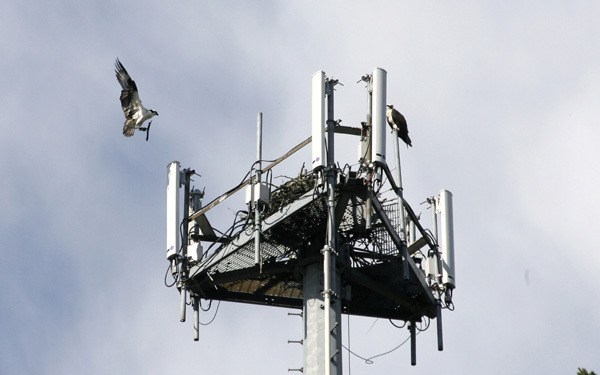For most islanders, the cell towers dotting the landscape hold value in their ability to keep cell phones ringing. To the osprey, they are simply home.
The migratory birds are returning to the Northwest this month, after wintering in Mexico and a few are beginning the process of building their lavish nests on the tall towers in the area.
Cell phone tower nests are an increasingly common sight in the Northwest, state Fish and Wildlife District biologist Jeff Skriletz said.
“They can get absolutely massive,” Skriletz said, “like a Volkswagen sitting up there.”
The nests can also be a source of friction between avians and service providers. Sometimes the stick piles cause equipment malfunctions or interfere with signals.
But bird lovers can rest easy. State and federal law prevents homeowners from tampering with nests. Skriletz said companies can modify the nests outside of the breeding period, which lasts from April to September, but modifications require state approval and careful oversight. In some cases the state has allowed property owners to remove a nest while building an alternative nesting platform nearby.
“The ospreys on towers (are) getting to be a real issue,” Skriletz said. “We still need to work out a statewide approach to it.”
Mike Pratt of the West Sound Wildlife Shelter said there is an osprey nest at the cell tower on Day Road at the intersection of State Route 305 and another near Battle Point. A cell tower nest also was reported at the back end of the Grand Forest.

“The height and location of the towers are close to water or good hunting, which is an attractive feature for the bird,” said Pratt. “Osprey like to find the highest point so they can scope out the area and cell phone towers are usually above the trees.”
Cell phone towers and power poles make ideal nest sites because of their broad platforms and wide viewing areas.
Some utility companies are building structures on or near their towers to accommodate nests or to dissuade would-be nest builders.
But the potential for danger is still there, Pratt said, as eagles have been electrocuted and caused outages. Pratt is also concerned about the long-term effects of a bird nesting on or near an electrical current. He said that there isn’t much information or research to determine what effect that might have on the bird’s life.
As birds return over the next couple weeks they will seek out their old nests and rejoin their mates for the spring breeding season. Osprey lay up to five eggs, which take about 50 days to hatch.
Osprey populations have been on the rise since their numbers were devastated by DDT and other toxins in the mid-20th century.
If handled properly, the ospreys and towers can coexist, Skriletz.
“You can have your tower, have the osprey and the public loves them,” Skriletz said.
Tad Sooter, reporter for the North Kitsap Herald wrote this story. The Review’s Jessica Hoch also contributed to this report.



